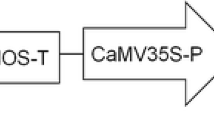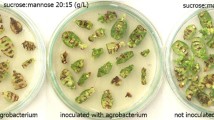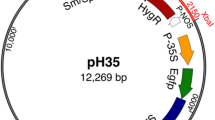Abstract
Efficient Agrobacterium tumefaciens-mediated transformation and a higher recovery of transformed plants of cucumber cv. Poinsett76 were achieved via direct organogenesis from cotyledon explants. Stable transformants were obtained by inoculating explants with A. tumefaciens strains EHA105 or LBA4404, both harboring the binary vector pME508, which contains the neomycin phosphotransferase II (nptII) and phosphinothricin resistance genes (bar) conferring resistance to kanamycin and PPT, respectively, as selectable markers and the sgfp-tyg gene for the green fluorescent protein (GFP) as a visual marker driven by the constitutive CaMV35S promoter in the presence of acetosyringone (50 μM). Transformed shoots were obtained on MS Murashige and Skoog (Plant Physiol. 15: 473–497, 1962) medium supplemented with 1 mg L−1 benzyladenine (BA), 20 mg L−1 l-glutamine and 2 mg L−1 phosphinothricin (PPT) or 100 mg L−1 kanamycin. The regenerated shoots were examined in vivo using a hand-held long wave UV lamp for GFP expression. The GFP screening helped identify escapes and chimeric shoots at regular intervals to increase the growth of transformed shoots on cotyledon explants. Elongation and rooting of putative transformants were achieved on PPT (2 mg L−1) containing MS media with 0.5 mg L−1 gibberellic acid (GA3) and 0.6 mg L−1 indole butyric acid (IBA), respectively. PCR and Southern analyses confirmed the integration of the sgfp gene into the genome of T0 and the progenies. T1 segregation of transgenic progeny exhibited Mendelian inheritance of the transgene. The use of EHA105 resulted in 21% transformation efficiency compared to 8.5% when LBA4404 was used. This higher rate was greatly facilitated by PPT selection coupled with effective screening of transformants for GFP expression, thus making the protocol highly useful for the recovery of a higher number of transgenic cucumber plants.



Similar content being viewed by others
References
Anonymous (2005) Food and Agriculture Organization of the United Nations, Statistics Division. In: http://faostat.fao.org
Baranski R.; Klocke E.; Schumann G. Green fluorescent protein as an efficient selection marker for Agrobacterium rhizogenes mediated carrot transformation. Plant Cell Rep 25: 190–197; 2006. doi:10.1007/s00299-005-0040-2.
Chalfie M.; Tu Y.; Euskirehen G.; Ward W. W.; Prasher D. C. Green fluorescent protein as marker for gene expression. Science 263: 802–805; 1994. doi:10.1126/science.8303295.
Chee P. P. Transformation of Cucumis sativus tissue by Agrobacterium tumefaciens and the regulations of transformed plants. Plant Cell Rep 9: 245–248; 1990. doi:10.1007/BF00232293.
Chee P. P.; Slightom J. L. Transfer and expression of Cucumber Mosaic Virus Coat protein gene in the genome of Cucumis sativus. J Amer Soc Sci Hortic 116: 1098–1102; 1991.
Chilton M. D.; Currier T. C.; Farrand S. K.; Bendich A. J.; Gordon M. P.; Nester E. W. Agrobacterium tumefaciens DNA and PS8 bacteriophage DNA not detected in crown gall tumors. Proc. Natl. Acad. Sci. 71: 3672–3676; 1974. doi:10.1073/pnas.71.9.3672.
Chiu W. L.; Niwa Y.; Zeng W.; Hirano T.; Kobayashi H.; Sheen J. Engineered GFP as a vital reporter in plants. Curr Biol 6: 325–330; 1996. doi:10.1016/S0960-9822(02)00483-9.
Cho H. J.; Widholm J. M. Agrobacterium tumefaciens-mediated transformation of the legume Astragalus sinicus using kanamycin resistance selection and green fluorescent protein expression. Plant Cell Tissue Organ Cult 69: 251–258; 2002. doi:10.1023/A:1015668132503.
Clemente R. M. P.; Sanjuan A. P.; Ferriz L. G.; Beltran J. P.; Canas L. A. Transgenic peach plants (Prunus persica L.) produced by genetic transformation of embryo sections using the green fluorescent protein (GFP) as an in vivo marker. Mol Breed 14: 419–427; 2005. doi:10.1007/s11032-005-0506-5.
Dellaporta S. C.; Wood J.; Hicks J. B. A plant DNA mini preparation, version II. Plant Mol Biol Report 1: 19–21; 1983. doi:10.1007/BF02712670.
Gaba V.; Feldmesser E.; Gal-On A.; Kles H.; Antignus Y. Genetic transformation of a recalcitrant melon (Cucumis melo L.) variety. In: Lester G.; Dunlop J. (eds) Cucurbitaceae 94. Gateway, Edinburg, pp 188–190; 1995.
Gambley R. L.; Dodd W. A. An in vitro technique for production of de novo of multiple shoots in cotyledon explants of cucumber (Cucumis sativus L.). Plant Cell Tissue Organ Cult 20: 177–183; 1990. doi:10.1007/BF00041879.
George E. F. Plant propagation by tissue culture—part 2: The technology, Exegetics Limited. Edington, Wilts, England: 50; 1996
Ghorbel R.; Juarez J.; Navarro L.; Pena L. Green fluorescent protein as a screenable marker to increase the efficiency of generating transgenic woody fruit plants. Theor Appl Genet 99: 350–358; 1999. doi:10.1007/s001220051244.
Halfhill M. D.; Richards H. A.; Mabon S. A.; Stewart C. N. Expression of GFP and Bt transgene in Brassica napus and hybridization and introgression with Brassica rapa. Theor Appl Genet 103: 659–667; 2001. doi:10.1007/s001220100613.
Jefferson R. A.; Kavanagh T. A.; Bevan M. W. GUS fusions: beta-glucuronidase as a sensitive and versatile gene fusion marker in higher plants. EMBO J 6: 3901–3907; 1987.
Kaeppler H. F.; Carlson A. R.; Menon G. K. Routine utilization of green fluorescent protein as a visual selectable marker for cereal transformation. In Vitro Cell Dev Biol-Plant 37: 120–126; 2001. doi:10.1007/s11627-001-0023-0.
Molinier J.; Himber C.; Hahne G. Use of green fluorescent protein for detection of transformed shoots and homozygous offspring. Plant Cell Rep 19: 219–223; 2000. doi:10.1007/s002990050002.
Murashige T.; Skoog F. A revised medium for rapid growth and bioassays with tobacco tissue cultures. Plant Physiol 15: 473–497; 1962. doi:10.1111/j.1399-3054.1962.tb08052.x.
Muruganantham M.; Amutha S.; Selvaraj N.; Vengadesan G.; Ganapathi A. Efficient Agrobacterium-mediated transformation of Vigna mungo using immature cotyledonary-node explants and phosphinothricin as the selection agent. In Vitro Cell Dev Biol 43: 550–557; 2007. doi:10.1007/s11627-007-9060-7.
Nishibayashi S.; Kaneko H.; Hayakawa T. Transformation of cucumber (Cucumis sativus L.) plants using Agrobacterium tumefaciens and regeneration from hypocotyl explants. Plant Cell Rep 15: 809–814; 1996. doi:10.1007/BF00233145.
Oridate T.; Atsumi H.; Ito S.; Araki H. Genetic difference in somatic embryogenesis from seed in melon (Cucumis melo L.). Plant Cell Tissue Organ Cult 29: 27–30; 1992. doi:10.1007/BF00036142.
Pigeaire A.; Abernethy D.; Smith P. M.; Simpson K.; Fletcher N.; Lu C. Y.; Atkins C. A.; Cornish E. Transformation of a grain legume (Lupinus augustifolius L.) via Agrobacterium tumefaciens-mediated gene transfer to shoot apices. Mol Breed 3: 341–349; 1991. doi:10.1023/A:1009642620907.
Rajagopalan P. A.; Perl-Treves R. Improved cucumber transformation by a modified explant dissection and selection protocol. Hortic Sci 40: 431–435; 2005.
Raharjo S. H. T.; Hernandez M. O.; Zhang Y. Y.; Punja Z. K. Transformation of pickling cucumber with chitinase-encoding genes using Agrobacterium tumefaciens. Plant Cell Rep 15: 591–596; 1996. doi:10.1007/BF00232459.
Sambrook J.; Fritsch E. F.; Maniatis T. Molecular cloning: a laboratory manual. 2nd ed. Cold Spring Harbor Laboratory Press, Woodbury; 1989.
Sapountzakis G.; Tsaftaris A. S. Transfer and expression of the firefly luciferase gene in cucumber. Cucurbit Genet Coop Rep 19: 38–41; 1996.
Sarmento G. G.; Alpert F. A.; Tang S.; Punja Z. K. Factors influencing Agrobacterium tumefaciens mediated transformation and expression of kanamycin resistance in pickling cucumber. Plant Cell Tissue Organ Cult 31: 185–193; 1992. doi:10.1007/BF00036222.
Schulze J.; Balko C.; Zellner B.; Koprek T.; Hansch R.; Nerlich A.; Mendel R. R. Biolistic transformation of cucumber using embryogenic suspension cultures: long-term expression of reporter genes. Plant Sci 112: 197–206; 1995. doi:10.1016/0168-9452(95)04261-X.
Selvaraj N.; Vasudevan A.; Manickavasagam M.; Kasthurirengan S.; Ganapathi A. High frequency shoot regeneration from cotyledon explants of cucumber via organogenesis. Sci Hortic-Amsterdam 112: 2–8; 2007. doi:10.1016/j.scienta.2006.12.037.
Stewart Jr. C. N. The utility of green fluorescent protein in transgenic plants. Plant Cell Rep 20: 376–382; 2001. doi:10.1007/s002990100346.
Tabei Y.; Kitade S.; Nisihizawa Y.; Kikuchi N.; Kayano T.; Hibi T.; Akutsu K. Transgenic cucumber plants harboring a rice chitinase gene exhibit enhanced resistance to gray mold (Botrytis cinerea). Plant Cell Rep 17: 159–164; 1998. doi:10.1007/s002990050371.
Tabei Y.; Nishio T.; Kusihara K.; Kanno T. Selection of transformed callus in a liquid medium and regeneration of transgenic plants in cucumber (Cucumis sativus L.). Breed Sci 44: 47–51; 1994.
Trulson A. J.; Simpson R. B.; Shahin E. A. Transformation of cucumber (Cucumis sativus L.) plants with Agrobacterium rhizogenes. Theor Appl Genet 73: 11–15; 1986. doi:10.1007/BF00273711.
Vengadesan G.; Prem Anand R.; Selvaraj N.; Perl-Treves R.; Ganapathi A. Transfer and expression of nptII and bar genes in cucumber (Cucumis sativus L.). In Vitro Cell Dev Biol 41: 17–21; 2005. doi:10.1079/IVP2004602.
Wehner T. C.; Cade R. M.; Locy R. D. Cell, tissue and organ culture techniques for genetic improvement of cucurbits. In: Bates D. M.; Robinson R. M.; Jeffrey C. (eds) Biology and Utilization of the Cucurbitaceae. Cornell University, Ithaca; 1990.
Yin Z.; Bartoszewski G.; Szwacka M.; Malepszy S. Cucumber transformation methods—the review. Biotech 1: 95–113; 2005a.
Yin Z.; Pląder W.; Wiśniewska A.; Szwacka M.; Malepszy S. Transgenic cucumber—a current state. Folia. Hortic 17/1: 73–90; 2005b.
Zhang M.; Cui H.; Wang B.; Jia S. Stimulatory effects of different cytokinin on direct plant regeneration from cotyledon explants in Cucumis sativus L. Cucurbit Genetic Coop Rep 24: 13–16; 2001.
Acknowledgments
The senior author gratefully acknowledges the University Grants Commission (UGC), Government of India, for the award of the teacher fellowship under the Faculty Improvement Programme (FIP), IX plan. The authors thank Dr. Rafael Perl-Treves, Bar Ilan University, Israel for kindly providing the construct under the Indo-Israel collaborative programme (No. DST/INT/ISR/PROJ/(B-1)/97, 1998–2001) and Dr.V. Irudayaraj for photography.
Author information
Authors and Affiliations
Corresponding author
Additional information
Editor: D. T. Tomes
Rights and permissions
About this article
Cite this article
Selvaraj, N., Kasthurirengan, S., Vasudevan, A. et al. Evaluation of green fluorescent protein as a reporter gene and phosphinothricin as the selective agent for achieving a higher recovery of transformants in cucumber (Cucumis sativus L. cv. Poinsett76) via Agrobacterium tumefaciens . In Vitro Cell.Dev.Biol.-Plant 46, 329–337 (2010). https://doi.org/10.1007/s11627-010-9288-5
Received:
Accepted:
Published:
Issue Date:
DOI: https://doi.org/10.1007/s11627-010-9288-5




